The month of October is recognised internationally as “Breast Cancer Awareness month” (BCAM), a tradition dating back to 1985, with many activities set aside to promote the awareness of the Breast cancer burden/scourge.
The “Pink Ribbon” (and the colour Pink) is the internationally accepted symbol of Breast cancer awareness and advocacy, a practice that first evolved in 1991.


Cancer is an uncontrolled (or rather “out of control) rapid proliferation of abnormal cells which make up body organs following the loss of normal genetic growth regulatory mechanisms of the cells with resultant extension beyond usual anatomic borders and a propensity for local and distant metastasis (spread), increased metabolic demands and other pathological changes/consequences that may ultimately lead to death of the patient.
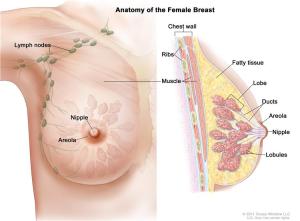
Breast cancer is the most common cancer in women worldwide with nearly 1.5 million cases diagnosed annually and about 500, 000 annual deaths.
A general estimate is that 1 in every 8 adult female worldwide is at risk of breast cancer development.
It’s pertinent to state at this point that breast cancer also sffects males, with a much less incidence rate but poorer prognosis. The prognosis and survival rate following breast cancer diagnosis is largely dependent on time/stage of diagnosis, morphological subtype, and availability of appropriate treatment options. Early diagnosis usually confers a good prognosis and better chances of survival! Unfortunately, this is where most under-developed parts of the world like Africa are failing significantly. Although the incidence of breast cancer in Africa is not as high as much of the developed world,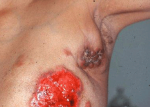
There are several different types of breast cancer; classification is usually based on particular type of breast tissue/cells affected or pathogenetic characteristics of the abnormal cells. The discussion of the various types of breast cancer is beyond the scope of this basic piece which is largely geared at creating awareness.
Risk Factors
While it is often not possible to identify specific risk factors for the majority of patients presenting with breast cancer, several risk factors have been well documented. These include;
-
1. Family History: the existence of a diagnosis of breast cancer in a relative significantly increases the risk of also having a similar diagnosis.
-
2. Genetic mutations:Some mutations, particularly in the BRCA1, BRCA2 and p53 genes result in a very high risk for breast cancer. However, these mutations are rare and account for a small portion of the total breast cancer burden. It is the discovery of this gene mutation that prompted Angelina Jolie’s decision to have a bilateral mastectomy. Several advanced societies now use such genetic screening as a method of breast cancer control.
-
3. Reproductive factors: these are factors associated with prolonged exposure to endogenous oestrogens (naturally occurring female reproductive hormones). It includes early menarche (first menstrual flow), late menopause (end of menstrual flows), and late/delayed conception (late age at first childbirth).
-
4. Exogenous hormones: such as oral contraceptives, hormone replacement therapy, etc. Users of these are at higher risk than non-users.
-
5. Modifiable factors: such as significant alcohol consumption, obesity/overweight, and physical inactivity.
PS: Note that breastfeeding (especially for long duration) exerts a protective influence against breast cancer!
The differences in breast cancer incidence between developed and developing countries can partly be explained by dietary effects combined with later first childbirth, lower parity (number of children), and shorter breastfeeding. The increasing adoption of western life-style in low- and middle-income countries is an important determinant in the increase of breast cancer incidence in these countries.
Symptoms
As with any other form of cancer, the earliest stages are usually asymptomatic and diagnosis at this stage is usually a chance event occurring during routine check-ups or inadvertently during evaluation for othet conditions.
When symptoms do set occur, they include;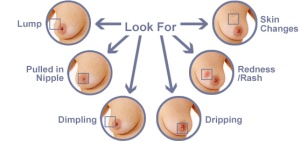
-
1. Lump: A lump is an unusual, often circumscribed/well defined, palpable thickening of breast tissue. It is usually the earliest apparent symptom of breast cancer. Characteristically, breast cancer associated lumps are usually painless. Some ladies usually have lumps during certain times in their monthly cycle but one that persists all through is very unusual. While most lumps detected are innocuous/benign, the finding of a lump should always prompt a medical consultation and examination by a clinician. A mammography can detect a lump long before it becomes visible or palpable!
-
2. Pain: Although most breast cancers are initially painless, pain in the breast may be a sign of breast cancer.
-
3. Asymmetry: While it is very common and normal to observe differences in size between both breasts in any individual, a sudden discovery of previously unnoticed asymmetry or exaggeration of same should prompt further evaluation.
-
4. Discharge: The presence of unusual breast/nipple discharge, especially a bloody or mucoid discharge, should prompt urgent evaluation.
-
5. Dimpling: Any noticeable flattening or indentation of the breast may indicate an underlying tumour that is not yet obvious.
-
6. Lymph node swelling: As with any tumor or inflammatory process, the local lymph nodes draining the affected tissue are usually palpably swollen. Because of the anatomy of the breasts which extend into the armpit (axillary tail) and the arrangement of the draining lymph nodes, most of which are in the armpit, any swelling in this area should be noted and prompt further evaluation.
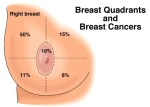 This is especially so considering the fact that the upper outer quadrant of the breast is the most common site/origin of breast cancers.
This is especially so considering the fact that the upper outer quadrant of the breast is the most common site/origin of breast cancers. -
7. Any change in the size, contour, texture, or temperature of the breast. A reddish, pitted surface like the skin of an orange (peau d’orange) could be a sign of advanced breast cancer.
-
8. Changes in the nipple, such as a nipple retraction, dimpling, itching, a burning sensation, or ulceration. A scaly rash of the nipple is symptomatic of Paget’s disease, which may be associated with an underlying breast cancer.
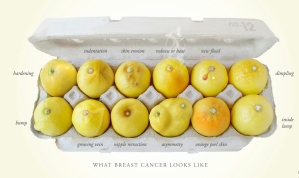
An observation of any of the above symptoms or other unusual changes in the breast and surrounding tissue should never be disregarded, rather it should prompt an urgent medical/specialist consultation. It’s better and safer to visit the doctor and be told that the suspicious change observed is no cause for worry, than to disregard it and end up presenting with an advanced cancer of the Breast.
Control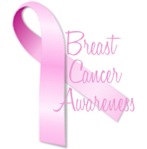
Awareness and early detection are the two most important tools in breast cancer control. Screening is also an important tool but unlike in cervical cancer, breast cancer has a paucity of cheap/cost effective, highly sensitive/specific mass screening tools with proven efficacy in low-resource settings. However, mammography has been used with good results in at-risk populations!
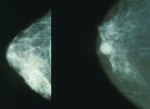
 Breast self-examination (BSE): In low-resource settings like ours, BSE has been advocated as a valuable tool to aid early detection of anomalies in the breast that could be indicative of breast cancer. Although there is little or no evidence of its effectiveness as a screening tool, it’s practice has been observed to empower women by making them responsible for their own health. By making BSE a regular practice, women and girls are able to learn to recognise subtle changes in their breasts that could be a pointer to underlying pathology. BSE in itself is not a diagnostic tool and should NEVER be conceived or mistaken as such! The presence of an unusual finding on examination should prompt an immediate consultation of a health practitioner.
Breast self-examination (BSE): In low-resource settings like ours, BSE has been advocated as a valuable tool to aid early detection of anomalies in the breast that could be indicative of breast cancer. Although there is little or no evidence of its effectiveness as a screening tool, it’s practice has been observed to empower women by making them responsible for their own health. By making BSE a regular practice, women and girls are able to learn to recognise subtle changes in their breasts that could be a pointer to underlying pathology. BSE in itself is not a diagnostic tool and should NEVER be conceived or mistaken as such! The presence of an unusual finding on examination should prompt an immediate consultation of a health practitioner.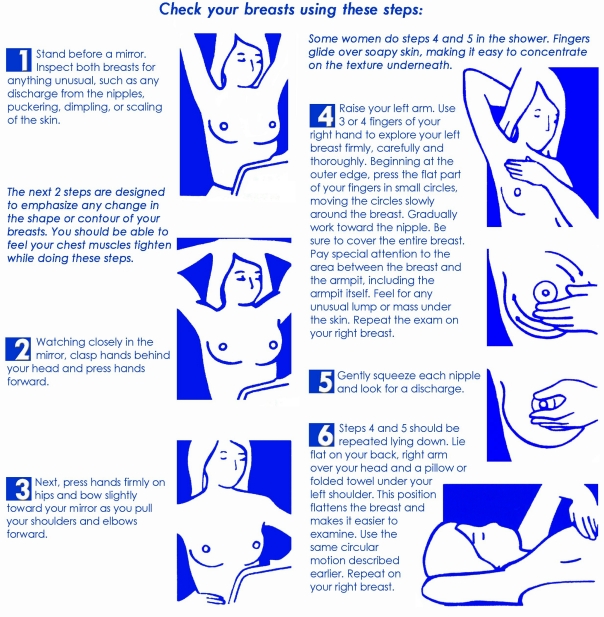
-
Genetic screening: This is not routinely available in most developing countries but is a useful tool in developed countries with a high incidence of breast cancer. In some of these “privileged” societies, it is used as a screening tool especially in the presence of a significant family history of breast cancer or other gynaecological malignancies.
-
Prevention: The advocacy of reduction in the modifiable risk factors such as alcohol consumption, obesity and inactivity have been recommended as practical areas of breast cancer burden reduction.A vast proportion of breast cancer related mortality in sub-saharan Africa are needless and preventable deaths.
-
Early diagnosis: Improved awareness, early recognition of anomalies and prompt presentation to properly equipped health facilities with appropriately skilled manpower are important positive prognostic indices when breast cancer does occur. Histology and cytopathological analysis following surgical biopsy of unusual/suspicious breast lesions are the usual gold standards in diagnosis of breast cancer as with virtually any cancer. It is important that patients insist on having a histological examination of any breast tissue following surgery at peripheral facilities, if that is not the routine practice in such settings.
Treatment
Treatment options for breast cancer depends on the stage of the disease at which it is detected and the histo-pathological diagnosis. Usual options include Surgery, Radiotherapy, and Systemic (drug) therapy. A combination of any of these methods may also be used.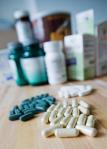
Treatment is most successful when the breast cancer is detected/diagnosed early. Late diagnosis is associated with a worse outcome and poor survival rates.
Would you opt for a Mastectomy (surgical removal of the breasts) if you found out you were at significant risk for breast cancer,although there’s no evidence of the cancer yet?

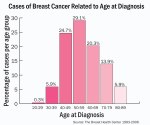
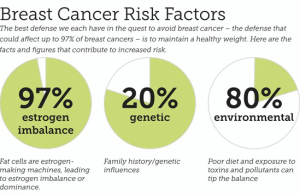

Thanks very much for this tangible information. Keep up d good work
Thanks for the comment. Keep sharing!
Thanks for this informative piece. Please where do I get to have a mammography at an affordable price. Thanks.
Most radiological facilities can carry out a mammography and it isn’t so expensive.
Take fruits which are high in Vitamin A content. Drink one to 3 glasses of carrot juice every day. This should be taken prior to your meal. Vitamin A is among the most crucial assists to our physique defense system which can help to fight our battle against cancer and prevent cancer development. Carrot juice will probably be a great all-natural cure for cancer.
Apparently everyone has cancer cells or pre-cancerous cells in their physique and also the body’s immune system disposes of those naturally. It is only when the immune system is down that the physique is unable to fight and dispose of those cells that they start to multiply to a detectable level.The malignant cells will not show up in tests till they’ve multiplied to a number of billion and when a doctor tells a patient that they no longer have cancer, it just indicates that they have gone back down to beneath the level of detection. It is for this exact same reason that, when carrying out surgery, physicians frequently find much more cancer than they anticipated from what was seen on Xrays and MRIs – simply because there had been cancer cells in other areas from the physique that had been still below the detectable rate.
Thank u so much for this information.its very helpful!
You are welcome! Please share it with your friends and loved ones. Also make out time to read our other blog posts.
We will by no means win the war against cancer with our current method. Whenever you understand what cancer is and why there’s a lot of it today you’ll comprehend why they’ll by no means find a remedy. It is exactly the same as trying to find a cure for scurvy which of course everybody knows is really a vitamin C deficiency illness. With scurvy it is effortlessly cured by consuming a meals item that consists of the missing vitamin.
I have been looking up info abut breast cancer/tumor/cysts. I have recently found a large lump that suddenly appereared and is quite sore, and this info has been helpful. I am a bit concerned about it possibly being cancer, being that it runs in the family, and am really concerned about not being able to afford any kind of treatment for it.
Thanks for sharing. This is wonderful and great for the awareness. Weldone doctor.